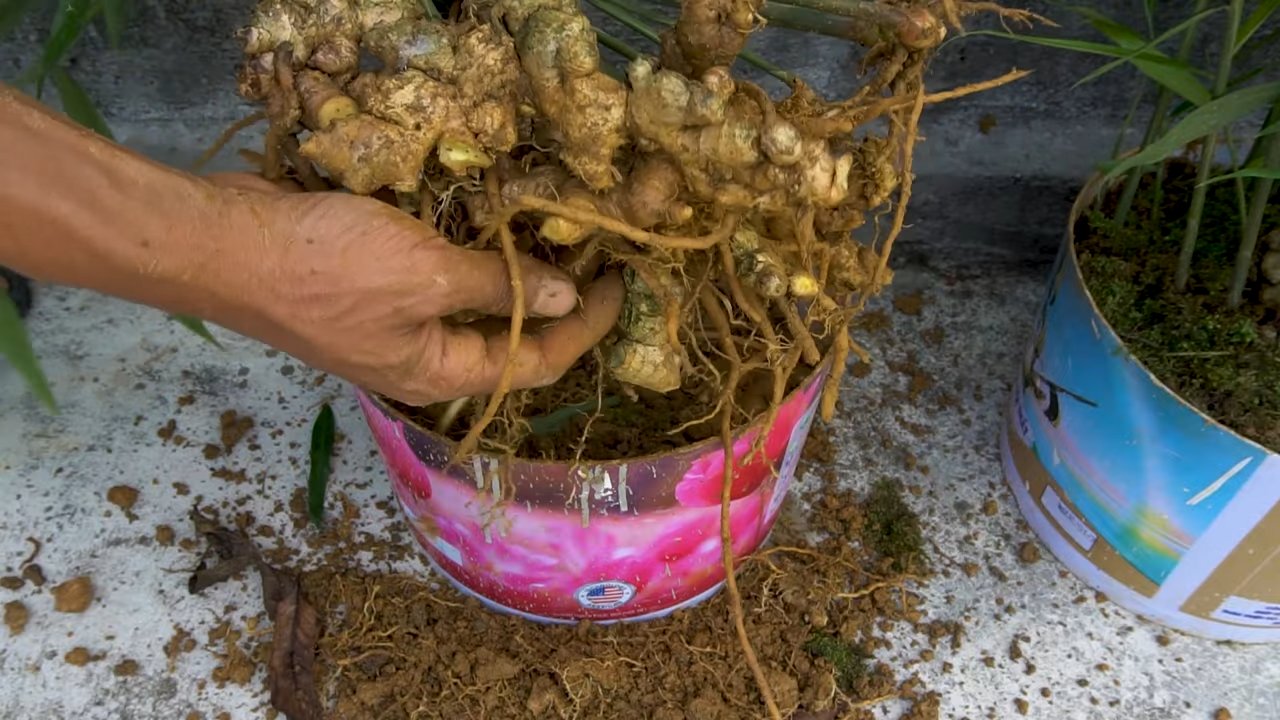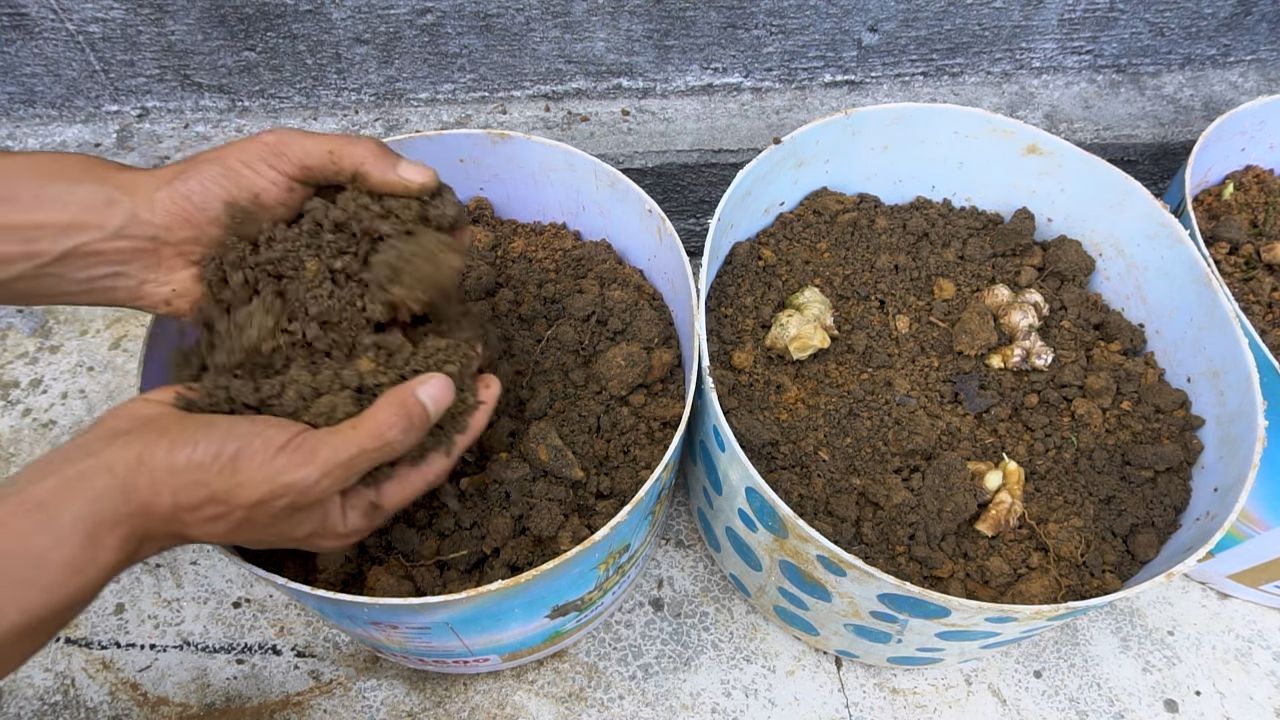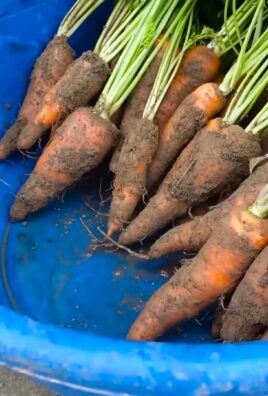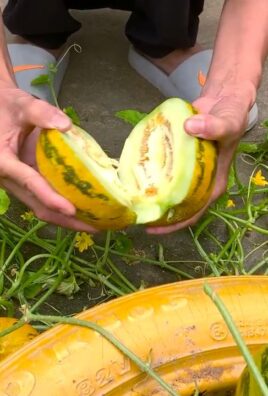Growing ginger in containers might sound intimidating, but trust me, it’s easier than you think! Imagine harvesting your own fresh, spicy ginger right from your patio – no more last-minute grocery store runs when your favorite recipe calls for it. For centuries, ginger has been prized not only for its culinary uses but also for its medicinal properties, playing a vital role in traditional medicine across Asia and beyond. From soothing upset stomachs to adding a zing to your stir-fries, ginger is a powerhouse ingredient.
But why should you bother growing it yourself? Well, store-bought ginger can sometimes be a bit lackluster, lacking the vibrant flavor of freshly harvested rhizomes. Plus, let’s be honest, who doesn’t love a good DIY project? This article is packed with simple, step-by-step instructions and insider tips to help you successfully cultivate your own ginger crop, even if you have limited space. We’ll cover everything from selecting the right container and soil to providing the optimal growing conditions. So, get ready to unleash your inner gardener and discover the joy of growing ginger in containers – you’ll be amazed at how rewarding it is!

Growing Ginger in Containers: A Beginner’s Guide
Hey there, fellow plant enthusiasts! Ever thought about growing your own ginger? It’s surprisingly easy, even if you don’t have a sprawling garden. Growing ginger in containers is a fantastic way to have fresh ginger on hand whenever you need it, and it’s a really rewarding experience. I’m going to walk you through everything you need to know, from choosing the right ginger to harvesting your own spicy rhizomes. Let’s get started!
What You’ll Need
Before we dive into the nitty-gritty, let’s gather our supplies. Here’s a checklist of everything you’ll need to successfully grow ginger in containers:
* Ginger Rhizome: Look for plump, healthy-looking ginger rhizomes at your local grocery store or nursery. Choose ones with visible “eyes” or buds. Organic ginger is often a good choice, as it’s less likely to have been treated with growth inhibitors.
* Container: A wide, shallow container is ideal. Ginger roots grow horizontally, so a pot that’s at least 12 inches wide and 8 inches deep will give them plenty of room to spread out. Make sure your container has drainage holes!
* Potting Mix: Use a well-draining potting mix. A mix of equal parts potting soil, compost, and perlite or vermiculite works great. This ensures good drainage and provides the ginger with the nutrients it needs.
* Watering Can or Hose: You’ll need a way to water your ginger regularly.
* Spray Bottle (Optional): Ginger likes humidity, so a spray bottle can help keep the leaves happy.
* Fertilizer (Optional): A balanced liquid fertilizer can give your ginger a boost, but it’s not essential.
* Warm, Shady Location: Ginger thrives in warm temperatures and partial shade.
Preparing Your Ginger Rhizome
This is a crucial step! Getting your ginger ready for planting will significantly increase your chances of success.
1. Soaking the Rhizome: Soak the ginger rhizome in lukewarm water for 12-24 hours. This rehydrates the rhizome and encourages the buds to sprout. I usually do this overnight.
2. Cutting the Rhizome (Optional): If your ginger rhizome is large, you can cut it into smaller pieces, making sure each piece has at least one or two “eyes” or buds. This will allow you to grow multiple ginger plants from a single rhizome. Let the cut pieces air dry for a day or two to prevent rot.
3. Sprouting the Rhizome (Optional but Recommended): While you can plant the rhizome directly, sprouting it first gives it a head start. Place the rhizome in a plastic bag with some slightly damp paper towels. Seal the bag and place it in a warm, dark place. Check it every few days and mist the paper towels if they start to dry out. You should see sprouts emerging in a week or two.
Planting Your Ginger
Now for the fun part – getting your ginger into its new home!
1. Fill the Container: Fill your container with the potting mix, leaving about an inch or two of space at the top.
2. Plant the Rhizome: Place the ginger rhizome on top of the soil, with the buds facing upwards. Cover the rhizome with about 1-2 inches of soil.
3. Water Thoroughly: Water the soil thoroughly until water drains out of the drainage holes. This helps settle the soil and provides the ginger with the moisture it needs to start growing.
4. Choose the Right Location: Place the container in a warm location that receives partial shade. Ginger prefers morning sun and afternoon shade. Avoid direct sunlight, which can scorch the leaves.
Caring for Your Ginger Plant
Consistent care is key to a healthy and productive ginger plant.
1. Watering: Keep the soil consistently moist, but not waterlogged. Water when the top inch of soil feels dry to the touch. Overwatering can lead to root rot, so make sure your container has good drainage.
2. Humidity: Ginger loves humidity. If you live in a dry climate, you can increase humidity by misting the leaves with a spray bottle regularly. You can also place the container on a tray filled with pebbles and water, making sure the bottom of the pot doesn’t sit directly in the water.
3. Fertilizing (Optional): If you want to give your ginger a boost, you can fertilize it every few weeks with a balanced liquid fertilizer diluted to half strength. Start fertilizing about a month after planting.
4. Temperature: Ginger thrives in warm temperatures, ideally between 70°F and 90°F (21°C and 32°C). Protect your plant from frost and cold temperatures. If you live in a colder climate, you may need to bring your container indoors during the winter.
5. Pest Control: Ginger is relatively pest-resistant, but keep an eye out for common pests like aphids or spider mites. If you notice any pests, you can treat them with insecticidal soap or neem oil.
Harvesting Your Ginger
The best part! Harvesting your own homegrown ginger is incredibly satisfying.
1. When to Harvest: You can start harvesting ginger about 8-10 months after planting. The leaves will start to turn yellow and brown, which is a sign that the rhizomes are mature.
2. Harvesting a Small Amount: If you only need a small amount of ginger, you can carefully dig around the edges of the container and harvest a piece of the rhizome. Be careful not to disturb the rest of the plant.
3. Harvesting the Entire Plant: If you want to harvest the entire plant, gently tip the container over and remove the soil and rhizomes.
4. Cleaning and Storing: Wash the rhizomes thoroughly to remove any soil. You can store fresh ginger in the refrigerator for several weeks. For longer storage, you can freeze it or pickle it.
Troubleshooting
Even with the best care, you might encounter a few challenges along the way. Here are some common problems and how to fix them:
* Yellowing Leaves: Yellowing leaves can be caused by overwatering, underwatering, or nutrient deficiencies. Check the soil moisture and adjust your watering accordingly. If you suspect a nutrient deficiency, try fertilizing with a balanced liquid fertilizer.
* Root Rot: Root rot is caused by overwatering and poor drainage. Make sure your container has drainage holes and that you’re not overwatering. If you suspect root rot, you may need to repot the plant in fresh potting mix.
* Lack of Growth: Lack of growth can be caused by insufficient light, cold temperatures, or poor soil. Make sure your plant is getting enough light and warmth. You may also need to amend the soil with compost or fertilizer.
* Pests: Keep an eye out for common pests like aphids or spider mites. Treat them with insecticidal soap or neem oil.
Tips for Success
Here are a few extra tips to help you grow the best ginger possible:
* Use High-Quality Potting Mix: A well-draining potting mix is essential for healthy ginger growth.
* Don’t Overwater: Overwatering is one of the most common mistakes people make when growing ginger.
* Provide Adequate Humidity: Ginger loves humidity, so mist the leaves regularly or place the container on a tray filled with pebbles and water.
* Be Patient: Ginger takes time to grow, so don’t get discouraged if you don’t see results immediately.
* Experiment: Don’t be afraid to experiment with different varieties of ginger and different growing conditions.
Enjoy Your Homegrown Ginger!
Growing ginger in containers is a fun and rewarding experience. With a little bit of care and attention, you can have fresh ginger on hand whenever you need it. I hope this guide has been helpful. Happy gardening!

Conclusion
So, there you have it! Growing ginger in containers is not only achievable, but it’s also a remarkably rewarding experience. Forget relying solely on store-bought ginger, often of questionable freshness and origin. With a little patience and the right setup, you can cultivate your own supply of this flavorful and healthful rhizome right in your backyard, balcony, or even indoors.
Why is this DIY trick a must-try? Firstly, the flavor of homegrown ginger is noticeably superior to what you typically find in supermarkets. It’s zestier, more aromatic, and possesses a vibrant intensity that will elevate your culinary creations. Secondly, you have complete control over the growing process, ensuring that your ginger is free from harmful pesticides and chemicals. This is particularly important for those who prioritize organic and sustainable living. Thirdly, it’s an incredibly satisfying project that connects you to the natural world. Watching your ginger plant sprout, grow, and eventually yield a bountiful harvest is a truly fulfilling experience.
Beyond the basic method outlined, there are numerous variations you can explore to tailor the process to your specific needs and preferences. For instance, experiment with different container sizes to see how they impact the yield. Larger containers generally allow for more extensive root development, potentially leading to a larger harvest. You can also try different soil mixes. While a well-draining potting mix is generally recommended, you might want to experiment with adding compost or other organic amendments to further enrich the soil and provide your ginger plants with the nutrients they need to thrive.
Consider companion planting as well. Certain herbs and flowers, such as marigolds and basil, can help deter pests and attract beneficial insects, creating a healthier growing environment for your ginger. Furthermore, you can adjust the amount of sunlight your ginger receives based on your climate. In hotter regions, providing some afternoon shade can prevent the leaves from scorching, while in cooler regions, maximizing sunlight exposure can help promote growth.
Don’t be afraid to get creative with your container choices. While plastic pots are perfectly functional, you can also use terracotta pots, repurposed buckets, or even grow bags. Just make sure that whatever container you choose has adequate drainage holes to prevent waterlogging.
Ultimately, the best way to learn is by doing. So, we wholeheartedly encourage you to give this DIY trick a try. Start small, experiment with different techniques, and don’t be discouraged if you encounter a few bumps along the way. Growing ginger in containers is a journey, and the rewards are well worth the effort.
We are confident that you’ll be amazed by the results. Imagine the satisfaction of adding freshly harvested ginger to your stir-fries, teas, and smoothies. Picture yourself sharing your homegrown ginger with friends and family, knowing that you cultivated it yourself.
We would love to hear about your experiences! Share your photos, tips, and challenges in the comments section below. Let’s create a community of ginger growers and learn from each other. Your insights could be invaluable to other readers who are just starting out. So, go ahead, get your hands dirty, and embark on this exciting adventure of growing ginger in containers. Happy gardening!
Frequently Asked Questions (FAQ)
Q: What kind of ginger should I use to start growing?
A: You can use ginger rhizomes purchased from most grocery stores. Look for plump, healthy-looking rhizomes with visible “eyes” or growth buds. Organic ginger is often preferred, as it’s less likely to have been treated with growth inhibitors. Avoid using powdered ginger or ginger that has been processed in any way. The goal is to find a fresh rhizome that is ready to sprout. If you can find ginger specifically sold for planting, that’s even better!
Q: How long does it take to grow ginger in a container?
A: It typically takes around 8-10 months from planting to harvest. However, you can start harvesting small pieces of ginger after about 4 months. The longer you let it grow, the larger and more mature the rhizomes will become. Be patient, and remember that growing conditions can influence the growth rate.
Q: What is the best type of container for growing ginger?
A: Choose a container that is at least 12 inches deep and wide. This will provide ample space for the ginger rhizomes to spread and develop. A wider container is generally better than a deeper one, as ginger roots tend to grow horizontally. Ensure the container has good drainage holes to prevent waterlogging, which can lead to root rot. Terracotta pots, plastic pots, and even grow bags can all be used successfully.
Q: What kind of soil is best for growing ginger?
A: Ginger prefers a well-draining, nutrient-rich soil. A good potting mix amended with compost or well-rotted manure is ideal. Avoid heavy clay soils, as they can retain too much moisture and hinder root growth. You can also add perlite or vermiculite to the soil mix to improve drainage. A slightly acidic to neutral pH (around 6.0 to 6.5) is optimal.
Q: How much sunlight does ginger need?
A: Ginger thrives in partial shade. Direct sunlight can scorch the leaves, especially in hot climates. Aim for about 2-3 hours of morning sun or dappled sunlight throughout the day. If you’re growing ginger indoors, place it near a bright window but away from direct sunlight.
Q: How often should I water my ginger plant?
A: Water your ginger plant regularly, keeping the soil consistently moist but not waterlogged. Allow the top inch of soil to dry out slightly between waterings. During the active growing season (spring and summer), you may need to water more frequently. Reduce watering during the dormant season (fall and winter).
Q: How do I fertilize my ginger plant?
A: Feed your ginger plant with a balanced liquid fertilizer every 2-3 weeks during the growing season. Look for a fertilizer with a ratio of 10-10-10 or similar. You can also use organic fertilizers, such as compost tea or fish emulsion. Avoid over-fertilizing, as this can damage the roots.
Q: How do I harvest ginger from a container?
A: You can start harvesting ginger after about 4 months by carefully digging around the edges of the container and snipping off small pieces of the rhizome. For a larger harvest, wait until the plant has matured for about 8-10 months. To harvest the entire plant, gently tip the container over and remove the soil, being careful not to damage the rhizomes.
Q: Can I grow ginger indoors?
A: Yes, you can successfully grow ginger indoors, provided you meet its basic needs. Ensure it receives adequate light (near a bright window), maintain consistent moisture, and provide good air circulation. You may also need to supplement with artificial light during the winter months.
Q: What are some common problems when growing ginger?
A: Some common problems include root rot (caused by overwatering), pests (such as aphids and spider mites), and fungal diseases. To prevent root rot, ensure your container has good drainage and avoid overwatering. Control pests by regularly inspecting your plants and using insecticidal soap or neem oil. Prevent fungal diseases by providing good air circulation and avoiding overhead watering.
Q: Can I save some of my harvest to replant for the next season?
A: Absolutely! In fact, that’s the best way to ensure a continuous supply of ginger. Select healthy, plump rhizomes from your harvest and store them in a cool, dry place until the next planting season. Make sure they don’t dry out completely. You can also store them in a plastic bag with some slightly damp peat moss.
Q: Is growing ginger in containers worth it?
A: Absolutely! The superior flavor of homegrown ginger, the satisfaction of growing your own food, and the ability to control the growing process make it a worthwhile endeavor. Plus, it’s a fun and educational project that can be enjoyed by gardeners of all skill levels. Give growing ginger in containers a try and experience the difference for yourself!




Leave a Comment